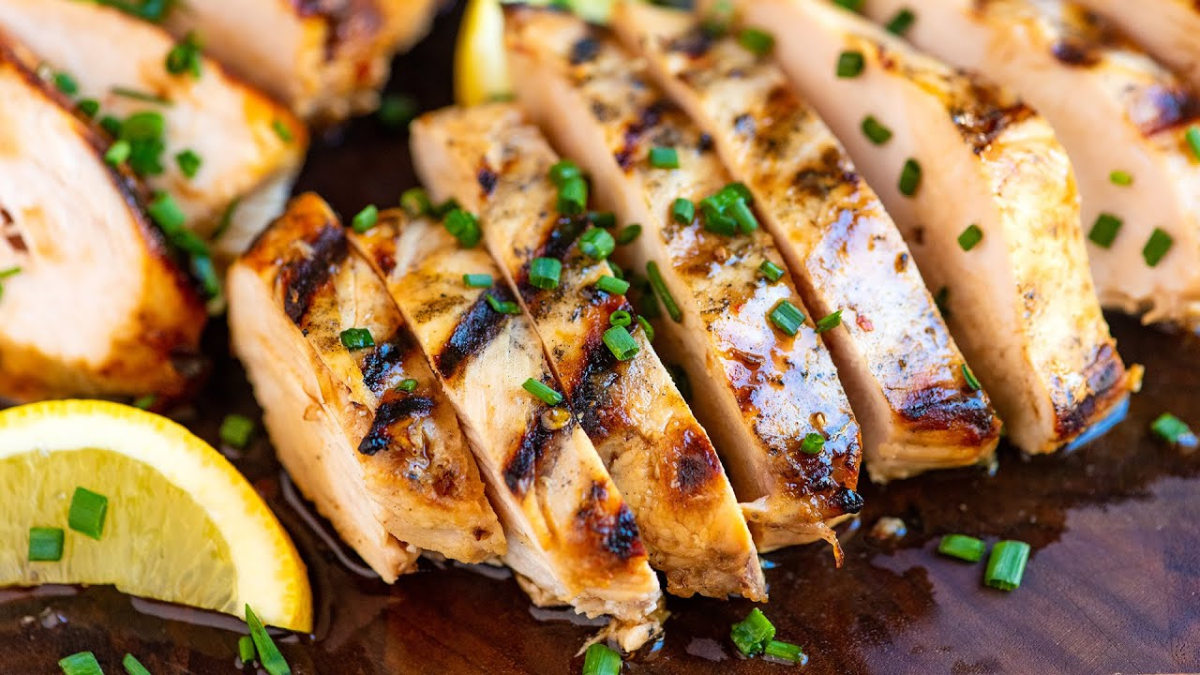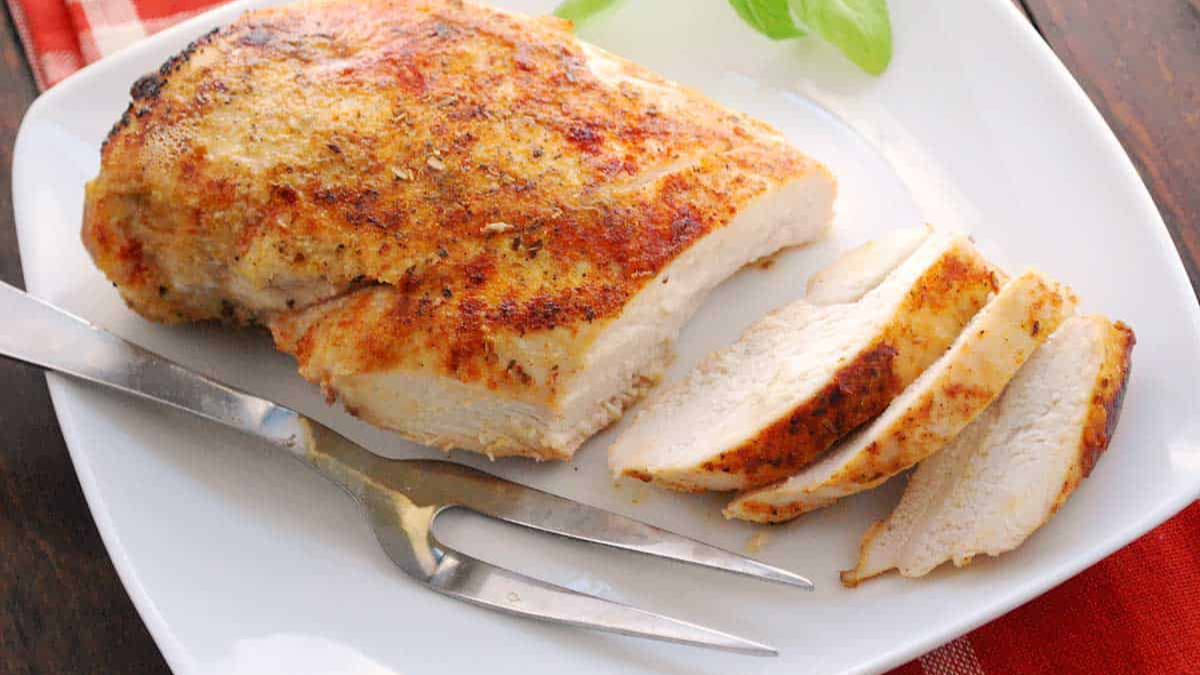If you wondered how to make a moist chicken breast, you have it on the right site; in this article, you will get all the crucial information about Moist Chicken Breasts. The secret to making moist chicken breast is to cook it at a lower temperature than usual.
A lower temperature results in a more tender chicken and allows the juices to redistribute through the breast. In addition to moist meat, cooking chicken at a lower temperature reduces the chance of the meat drying out. A good rule of thumb is to cook the chicken breast against the grain, which helps retain more juices.
Make sure your chicken has warmed to 165 degrees Fahrenheit inside. Overbaking should be avoided because it will make the meat dry. Always wait five minutes after cooking your chicken before slicing it.
This resting period is crucial for the juices to be evenly dispersed throughout the meat. Avoid skipping the resting period since the dry chicken will result from omitting this step. Slice the chicken against the grain after it has finished cooking. You will obtain the moistest chicken breast by doing this.
What is the Meaning of Moist Chicken Breast?
The healthiest chicken cut is the breast, particularly boneless, skinless breasts, which can taste bland and dry. With this ridiculously simple technique, you can prepare moist, tasty breasts with just a little salt, pepper, and olive oil.
It produces chicken that is ideal for cutting or shredding to add to salads, chicken pot pie, chicken noodle soup, and other dishes. Making chicken breast moist essentially means giving it more taste.
When we cook chicken breast, it tends to dry, preventing us from tasting the true flavor of the meat. However, when we cook chicken breast with moisture, we make it delicious and discover a new cooking technique.
How to Make Moist Chicken Breast?
Here is the best moist chicken breast recipe:
Ingredients:
- 1 to 4 Boneless, skinless chicken breasts of similar size.
- Salt
- Freshly ground black pepper
- 1 Tablespoon olive oil, unsalted butter, or a combination of both
Equipment:
- Heavy Mason jar or wide drinking glass
- Wide (10-inch) sauté pan with lid
- Tongs or spatula
Instructions:
- Pound the chicken breasts to an even thickness with the bottom of a wide jar or glass. You can also use the bottom of a small frying pan.
- Lightly season the chicken with salt and pepper.
- Over medium-high heat, preheat a frying pan big enough to hold the chicken in one layer. Add the olive oil once it is pretty heated (or butter, if using). Stir the oil around in the pan to coat it evenly.
- Heat reduction to medium. Chicken breasts should be added. To assist them in getting a little golden on one side, cook them without interruption for only approximately 1 minute (you are not searing or browning them).
- Flip each chicken breast over.
- Reduce the heat to low.
- Cover the pan with a tight-fitting lid. Set a timer for 10 minutes, and walk away. Do not lift the lid; do not peek.
- Immediately after 10 minutes, turn off the heat. (Remove the pan from the heat if your stove is electric.) Leave the chicken breasts in the pan and reset the timer for 10 minutes. Again, don’t peek or lift the lid.
- Uncover the chicken when the ten minutes are over, and it will be done. Make sure the chicken breasts are completely pink-free in the center. Use an instant-read thermometer to check the temperature of the chicken to ensure that it is fully cooked; the chicken should be at least 165°F. Slice and consume.
What Makes Chicken Breast Juicy?
Here are some ways to make your chicken breast juicy:
Using a Marinade
Any chicken should be marinated before cooking to maintain moisture. When marinating the chicken, keep the marinade moist and seal the bird for at least 3 to 4 hours; it is best to let the chicken soak in the flavor all night, especially if it will be grilled. As a result, the chicken will be able to absorb all the moisture from the marinade and retain all of its liquid content during cooking, making it soft.
A Quick Brine
Besides the use of yogurt and ground spices, bringing is comparable to marinating. You soak the chicken in a solution of salt, water, and a little sugar. Depending on your needs and the chicken you prepare, you can add whole spices. To keep the chicken moist during cooking, you can bring it for as many hours as possible.
Pounding the Chicken
Use a pounding motion to beat the chicken until it is small and thin. It may be excellent for roasting, grilling, or frying. If making a recipe for boneless chicken, pounding can be done.
It is used to tenderize the meat and aids in breaking down the meat’s fibers. It also enables speedier cooking, preventing overcooking and maintaining the dish’s moisture.
Avoid Over Cooking
We advise bringing a thermometer to precisely set the temperature, which will prevent you from overcooking the chicken if you are unsure of the ideal temperature to cook a particular type of chicken.
When grilling a chicken, cook it for 1.5 minutes on each side before placing it in the oven for 6 minutes at 356 F.
The Type of Pot you Use to Cook
The shape of a pot or pan is also a consideration and has a great deal to do with how food cooks. Deeper pots hold moisture inside and submerge much of the cooking food.
Foods cooking in the center of a huge vessel undergo a more constant temperature and somewhat increased pressure, which further help keep the food moist.
Higher Fat Content
A slightly higher fat content enhances the flavor and produces a much more tender and moist chicken. As the fat melts, it moistens the chicken’s cut, which is preferable in cooking chicken breasts.
Cook Only Room Temperature Chicken
One of the most crucial methods for keeping your chicken wet is to do this. Never cook frozen chicken straight from the freezer, as this could produce a bland, tasteless dish.
It should be marinated only when the chicken has rested for 30 minutes (or more) and reached room temperature. Even if you store the marinated chicken in the fridge, start cooking it just after it reaches the proper temperature.
Cook at the Right Temperature
Avoid placing your chicken pieces on the cold pan immediately as you heat the cooking vessel on the stove because many of the chicken’s liquids will evaporate as the pan heats up.
Wait until the skillet reaches the proper temperature before adding the pieces so the chicken begins to cook immediately without unnecessarily losing moisture.
Foiling
Near the conclusion of cooking, covering the chicken pieces with foil may stop the flesh from drying out.
The foil helps the chicken retain moisture, making it tender and supple.
Basting
Basting is the process of covering the chicken with oil or butter (or any other source of frying chicken) as it cooks.
While cooking, basting evenly distributes the liquids and keeps the chicken moist. Take the chicken out of the oven or grill after 20 to 30 minutes to baste it with butter or oil.
Which Mistakes to Avoid in Making Chicken Breast?
Are tough, dry chicken breasts something you detest? Change your method to ensure that your chicken remains juicy and flavorful. Many of us immediately gravitate toward the meat counter’s boneless, skinless fillets. It makes sense because their skin is poor, and they are simple to work with. However, leaving the skin on while cooking aids in maintaining the chicken’s moisture. (You can always remove it before starting.)
Dry chicken breasts are possible. After all, they aren’t as fatty as other portions of the bird. However, a good marinade, brine, or rub wonders for the meat’s flavor and moisture retention. If you’re after simplicity, a straightforward salt and pepper rub will do.
These Seven kitchen mistakes you should avoid to get moist and delicious chicken breasts:
- Chicken breasts can be pounded to make the meat soft. You begin to break down the proteins in the meat using your strength (and the power of a reliable meat tenderizer).
- Additionally, cooking the breasts thoroughly takes less time when they are thinner, which is useful since we frequently overcook them!
- Ensuring the chicken breasts are of the same thickness is advantageous if you’re cooking more than one breast. If not, it will probably not be easy to get them all to the required internal temperature (165° F) without drying out some.
- Salmonella and medium-rare chicken breasts are both unpleasant. But a chicken breast that has been overdone is rough and unpleasant to eat. Although recipes include helpful instructions for cooking, it might be challenging to determine when the chicken is fully cooked until you’ve had enough practice.
- You’ve probably seen the juices drip onto your plate if you’ve removed a piece of meat from the oven or the grill and immediately cut into it.
- You’d want to enjoy that juicy goodness in the flesh! Therefore, after the chicken has finished cooking, tent it with foil and let it rest on the counter for 10 minutes before serving.
- A piece of chicken that is cooked to perfection is unrivaled. But if it’s not right, a tasty sauce might help cover up some dryness. Of course, one of the best ways to add flavor is with a delicious sauce.
Conclusion
Select a large or medium-sized chicken breast for the best results. Larger breasts should be cooked for 18 to 20 minutes, while medium-sized breasts will take around 20 minutes. For the final two minutes of cooking, use the broiler to achieve the perfect golden-brown color and juicy interior. When done, beef should register 165 degrees Fahrenheit on a thermometer, though it might take longer. Your chicken will be cooked to perfection if you do this.
The marinade that works best for your chicken can be used when baking from frozen. Herbs and seasonings can also be used to season the breast. In a medium bowl, combine the ingredients for the marinade. Leave it for 30 minutes or overnight. After that, you may immediately include it in a recipe. You’ll always get moist chicken breast if you want a savory marinade or garlic.


